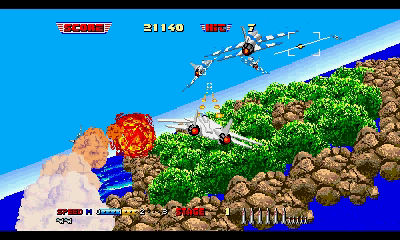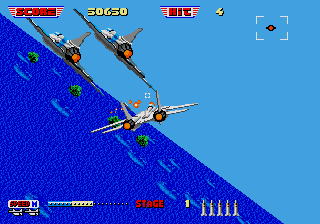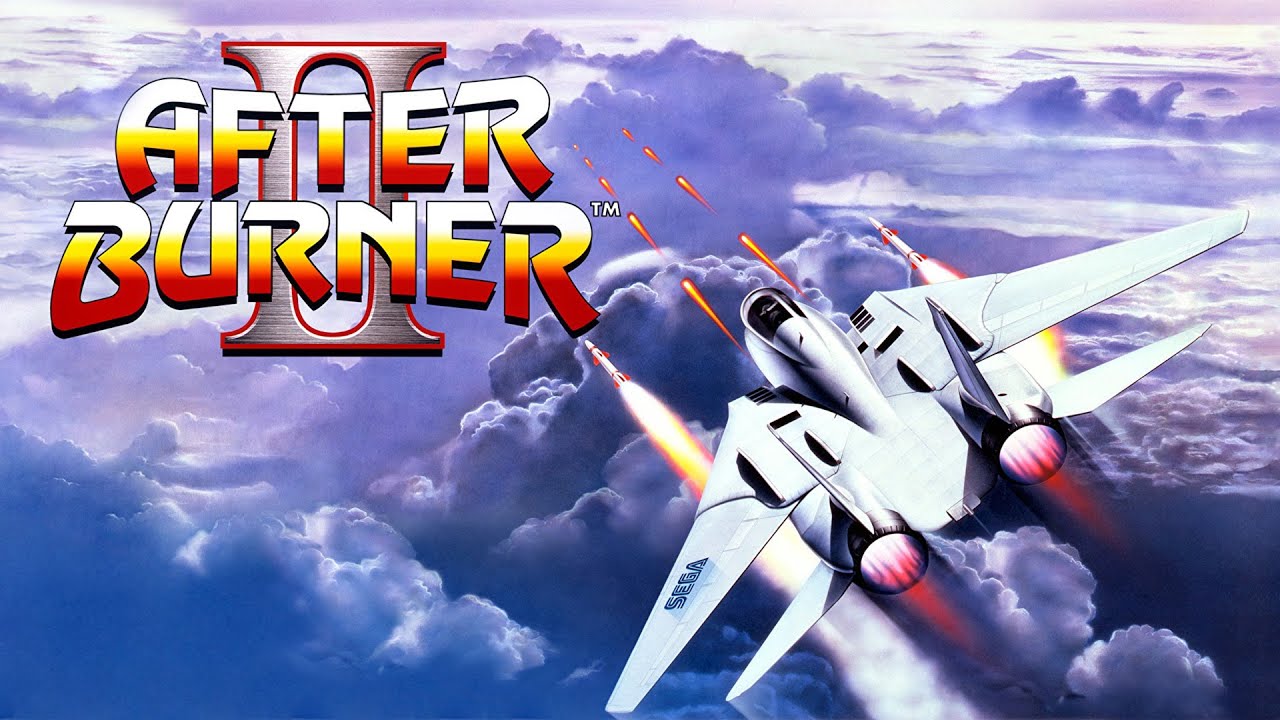Excusing the poor Latin, we are looking at 3D After Burner II, a port of the 1987 Sega arcade game. Published by Sega in 1990, After Burner II is a thrilling racing game with combat elements that captures all the elements that made the original cabinet version such a blast to play. Putting you into the seat of an F-14D Tomcat Jet Fighter armed to the teeth, pitting yourself against waves of heavy anti-air gunfire, waves of kamikaze planes, and guided missiles in multiple maps that blend flawlessly together. Although After Bruner II shares a kinship with the modern endless runner/ racing game, there are only 21 checkpoints due to contemporary hardware limitations. The “fake” 3D perspective makes the incoming threat all the most exciting compared to other games in the same vein as Star Force or even Metal Slug if we are being lax. The third-person perspective combined with threats and obstacles coming string at the play create artificial urgency and almost per-conditions players to play better, passing each obstacle a thrill and each successful missile hit a reason to cheer.
For the game’s narrative structure, there are a lot of ambiguities. Despite the original arcade cabinet being designed by Sega, a company known for releasing regional exclusive content, After Burner II puts you in control of an American jet fighter while hinting the enemy you are against is the Japanese Imperial Air force through enemy behaviors like trying to ram you when health is low, a mutation of the kamikaze tactic that is often inappropriate associate with the Japanese culture. The game seems to be heavily geared towards western audiences, with you piloting a heavily armed high-tech jet fighter blasting waves of outdated-looking propeller-driven fighters that sluggishly lumber towards you, playing into the idea of individual heroisms and romanticism that are gaining more traction during the end of WWII, and the game happens to release around one year before the official end of the war, seeming echoing the general sentiment of Western victory and aerial dominance.
 Besides analyzing how complementary culture shapes the game, we should also examine some critical gameplay mechanics, such as utilizing your devesting array of missiles. You engage missile lock with your crosshair that you aim around awkwardly with a controller. Missiles recharge over time and are great at taking down fast-moving targets that your chain gun is not able to track, plus there is little delay in launching multiple missiles to absolutely devastate your targets. In response to this, the developers implemented heavy smoke emissions for missile launches. Spamming your most powerful ordinance is a sure way to block your entire screen with zero-visibility smoke, and a sure way to quickly run out of lives in later stages when enemy gun fires are dense and unpredictable. This passive establishes a rule for the players to deal with trash mobs with the chain gun and prioritize high-value targets with the missile lock, creating minor procedural rhetoric of some sort.
Besides analyzing how complementary culture shapes the game, we should also examine some critical gameplay mechanics, such as utilizing your devesting array of missiles. You engage missile lock with your crosshair that you aim around awkwardly with a controller. Missiles recharge over time and are great at taking down fast-moving targets that your chain gun is not able to track, plus there is little delay in launching multiple missiles to absolutely devastate your targets. In response to this, the developers implemented heavy smoke emissions for missile launches. Spamming your most powerful ordinance is a sure way to block your entire screen with zero-visibility smoke, and a sure way to quickly run out of lives in later stages when enemy gun fires are dense and unpredictable. This passive establishes a rule for the players to deal with trash mobs with the chain gun and prioritize high-value targets with the missile lock, creating minor procedural rhetoric of some sort.
The game also dials up the excitement meter in later stages by introducing enemies that chase you from behind, laying down a hail of gunfire should your attention slips for but a moment, combined with the rain of ordinances launched from the horizon, After Burner II cleverly utilizes the illusion of perspectives to create a dynamic 3D environment akin to the rendering method of early fps prototypes like Wolfenstein 3D. This ingenious method of implementing 3D perspectives and interactive experiences dominates the contemporary market, and 3D After Burner II utilizes this to the fullest, painting an active picture of intense mid-air dog fights.
 The game is also not short of spectacular views, from scouring golden desert dotted with cactuses and occasional oasis, green plains populated with rocks, bushes, and birds to the navy base reminiscent of Peral Harbor, the game does not lack attractive environments and utilizing the more advanced graphics capabilities, 3D After Burner II allows you to perform a barrel roll that rotates the whole screen with the simple act of switching your control stick to one side and pulling up and again to another side or a simple shift on my onboard emulator. The dynamic day-night cycle adds another layer of wonder to your area racing experience and brings the challenge of navigating the environment during periods of low visibility, tasking you to respond to enemy gunfire with audio cues, with are unfortunately choppy but still innovative.
The game is also not short of spectacular views, from scouring golden desert dotted with cactuses and occasional oasis, green plains populated with rocks, bushes, and birds to the navy base reminiscent of Peral Harbor, the game does not lack attractive environments and utilizing the more advanced graphics capabilities, 3D After Burner II allows you to perform a barrel roll that rotates the whole screen with the simple act of switching your control stick to one side and pulling up and again to another side or a simple shift on my onboard emulator. The dynamic day-night cycle adds another layer of wonder to your area racing experience and brings the challenge of navigating the environment during periods of low visibility, tasking you to respond to enemy gunfire with audio cues, with are unfortunately choppy but still innovative.
Overall, 3D After Burner II is an excellent entry to the retro racing genre family, the excellent presentation of fast-paced racing mechanics and awe-inspiring actions makes this game one of my favorites, and the many decisions on design choices warrant future analysis with a focus on contemporary cultures and political senses.

